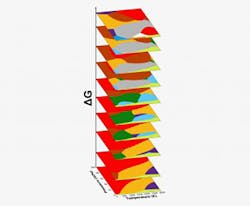Process Leverages Machine Learning to Accelerate Materials Analysis
What you’ll learn:
- The importance of understanding a material’s atomic structure.
- An automated process for identifying and exploring promising new materials.
We address the applications around us by using materials to create solutions, and everything we make is by definition made up of them. We discover some, and we create some, but commercializing materials for mainstream manufacturing can be tedious, expensive, and often based on trial and error.
A material’s atomic structure establishes its electronic, thermal, and mechanical properties. Scientists in this field are always looking for ways to arrange atoms to develop useful materials, often using high pressures and temperatures.
For example, diamond and graphite are considerably different in their material properties, but they’re just matrixes of carbon atoms arranged in an alternate structure. Each structural arrangement provides different capabilities to the resulting material, even if made up of the same element. Under normal conditions, graphite is a more stable form of carbon than diamond, but once changed by extreme pressure and heat, the carbon reaches the metastable diamond state.
Recently, scientists at the U.S. Department of Energy’s (DoE) Argonne National Laboratory demonstrated an automated process for identifying and exploring promising materials using machine learning and high-performance computing. This approach could accelerate the discovery and design of useful materials.
Starting with a single carbon molecule, the algorithm predicted the atomic order over a wide range of temperatures and pressures. The prototype then constructed a series of phase diagrams to help find useful states of matter.
“We trained a computer to probe, question, and learn how carbon atoms could be organized to create phases that we might not find on earth or that we don’t fully understand, thereby automating a whole step in the materials development process,” said Pierre Darancet, an Argonne scientist and author on the study. “The more of this process a computer can handle on its own, the more materials science we can get done.”
“It’s experimentally difficult to predict and produce states of matter that are not near equilibrium conditions,” said Jianguo Wen, an Argonne experimentalist on the study. “This new computational approach enables us to explore those little-known regions on the maps that aren’t otherwise accessible, or that we don’t yet even know exist.”
Algorithm Development
The machine-learning algorithm was trained with synthetic data to approximate the results the scientists expected, using molecular dynamics and density functional theory. The training data was produced using Carbon, a high-performance computing cluster at Argonne’s Center for Nanoscale Materials (CNM), a DoE Office of Science user facility. Also used were two other DoE user facilities: the Argonne Leadership Computing Facility and the National Energy Research Scientific Computing Center at Lawrence Berkeley National Laboratory.
The team then verified the efficacy by synthesizing actual material samples and characterizing them using a standard transmission electron microscope at CNM. They found that the algorithm successfully predicted well-known phase diagrams for carbon, and the computer-generated phase diagrams expanded our knowledge of several yet-unexplained experimental observations. This included the previously ambiguous structure of a theoretical material called “new diamond,” which has troubled scientists for over 30 years.
“Materials synthesis, especially of those with exotic properties, can often take several experimental trials and years of effort,” said Argonne scientist Subramanian Sankaranarayanan, a lead author on the study. “Our machine-learning algorithms allow us to identify the synthesis conditions of exotic materials, potentially reducing the time for their experimental realization.”
About the Author
Alix Paultre's Archive
Editor-at-Large
Also check out Alix's main author page for his latest articles.
An Army veteran, Alix Paultre was a signals intelligence soldier on the East/West German border in the early ‘80s, and eventually wound up helping launch and run a publication on consumer electronics for the US military stationed in Europe. Alix first began in this industry in 1998 at Electronic Products magazine, and since then has worked for a variety of publications in the embedded electronic engineering space. Alix currently lives in Wiesbaden, Germany.
Also check out hjis YouTube watch-collecting channel, Talking Timepieces.


